
Performing a regular windshield inspection is one of the most effective ways to catch issues before they become major problems. Your windshield takes on a lot of wear and tear, from flying debris to weather exposure, and small cracks or chips can quickly escalate if left unchecked. This post will guide you through the steps of a thorough windshield inspection, teaching you what to look for and how to prevent damage from worsening.
By incorporating these inspection practices into your routine, you can keep your windshield in excellent condition and ensure your vehicle is safe for the road.
Conducting a windshield inspection doesn’t require special tools, but it does require attention to detail. Here’s a step-by-step guide to help you check your windshield for signs of damage.
The most obvious sign of windshield damage is the presence of chips or cracks:
Even if you don’t see obvious cracks, your windshield might have other forms of damage that could affect visibility:
The integrity of the seals around your windshield is just as important as the glass itself:
Your windshield wipers can affect the condition of your glass if they aren’t in good shape:
Taking the time to perform a regular windshield inspection can save you from costly repairs and dangerous driving conditions. By identifying chips, cracks, or other issues early, you’ll keep your vehicle’s glass in top shape and avoid the risk of more serious damage. If you notice any signs of damage during your inspection, don’t hesitate—give us a call today for professional windshield services in San Pablo, Pittsburg, and Richmond, CA.